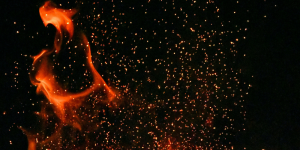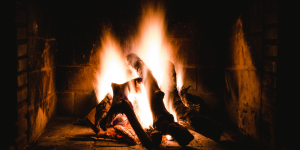A roaring fireplace could make any frosty evening cozy. Who wouldn’t like a comforting fire? Well, perhaps babies are an exception here. You cannot leave a baby around the fireplace without supervision for numerous reasons, including the obvious one; they may accidentally burn themselves. But there are certain safety reasons why babies should be kept away from fireplaces. Read on to know more, and you might want to check this learning guide on how to baby proof a fireplace at your home thinking about the safety of your children.
We’ve also listed the best baby gates for fireplaces, which you can check.
Why is a fireplace not ok for babies?

A fireplace can be safe for babies only if it has been perfectly installed, which, alas, is not always the case. More often than not, wood-burning, gas, or electric fireplaces are poorly installed, which can prove to be harmful to infants. The following are the two primary reasons why fireplaces can be damaging to young children, but, if the fireplace is already there you may want to add to your knowledge this written guide we have answering the question of what age do you need baby gates?
1. Emission of Carbon Monoxide
 Carbon Monoxide has a ton of deadly properties that can easily brew poison from an innocent-looking fireplace. When the fire is ignited and the smoke emitted from the fire is given little or no room to escape, it can become poisonous due to an increase in volume and density. While high levels of carbon monoxide can harm adults, in the case of babies, even a relatively low level can prove to be deadly.
Carbon Monoxide has a ton of deadly properties that can easily brew poison from an innocent-looking fireplace. When the fire is ignited and the smoke emitted from the fire is given little or no room to escape, it can become poisonous due to an increase in volume and density. While high levels of carbon monoxide can harm adults, in the case of babies, even a relatively low level can prove to be deadly.
You’d have a few clear indications if your infant is being affected due to the fumes, which is carbon monoxide in disguise, like gentle coughing, dizziness, or nausea. If the child displays any of these signs, they can be reacting to the poisonous gas, which is harmful but too low of a concentration to be harmful to you. This could breed respiratory illnesses in the child, especially if there have already been certain underlying symptoms of respiratory diseases. (1)
Studies have shown that numerous babies suffer around fireplaces because of the pollution emitted by the same thing that we perceive as comfortable.
2. Burn injuries
 You cannot expect a child to know that fire burns. The worst part is, the more you pull the baby away from fire, the more their inquisitive minds would be enticed to touch it. There’s no winning against that. This could cause the baby to burn its hands or legs.
You cannot expect a child to know that fire burns. The worst part is, the more you pull the baby away from fire, the more their inquisitive minds would be enticed to touch it. There’s no winning against that. This could cause the baby to burn its hands or legs.
Not only are wood-burning fireplaces dangerous in this regard, but also gas fireplaces, which can heat the iron parts of the fireplace, making them writhing hot. The infants could suffer from the following kinds of burns, according to the American Academy of Pediatrics:
- A First-degree burn: Mild burn that affects the first layer of the skin
- A Second-degree burn: Severe than the first-degree burn, as it affects the outer layer of the skin
- A Third-degree burn: Most severe burn affects the deeper tissues and results in white or blackened skin. (2)
These burns can be immensely painful to an infant, particularly if they have developed blisters and darkened skin because of it. The effects may be noticeable for a long time. Therefore, all precautions need to be taken to ensure that your child does not suffer from any of these burns.
There are a few measures you can take to ensure that your child does not suffer from such burns, nor is he subjected to the pollution caused by carbon monoxide. Primarily, make sure that the fireplace, wood-burning or gas, is installed perfectly.
While a fireplace can seem comforting, it can be detrimental to infants, especially if they already suffer from certain respiratory illnesses like asthma. Thus, always keep an eye on your baby when you’re sipping your cocoa in front of a roaring fire. If your child is acting up because of the fumes, take your baby outside and allow them to breathe some fresh air.
References
(1) respiratory illnesses – https://www.choc.org/news/7-common-respiratory-diseases/
(2) kinds of burns – https://www.webmd.com/first-aid/types-degrees-burns
